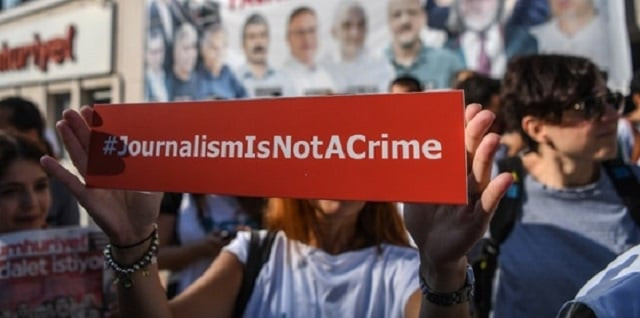Ending the culture of impunity
Each year one journalist gets a Pulitzer and one hundred get shot

A journalist holds a banner. PHOTO: AFP
In the past twelve years (2006-2017), the UN estimates that close to 1,010 journalists have been killed for reporting the news and bringing information to the public. What is unacceptable is that in nine out of 10 cases the killers go unpunished. Impunity leads to more killings and is often a symptom of worsening conflict and the breakdown of law and judicial systems. The ultimate sufferers are the people. Impunity damages whole societies by covering up serious human rights abuses, corruption, and crime.
Only last month, journalist Sohail Khan was shot and killed in Haripur just days after filing a story about the local drug mafia. Sohail had just left the District Police Office (DPO) in Haripur district of Khyber Pakhtunkhwa when he was shot at several times. He died at the scene. He was at the DPO filing an application for protection after receiving multiple death threats following his report on drug mafia in Pakistan. It is widely believed that members of the drug mafia killed Sohail in retaliation for his reporting.
If the government in Pakistan was quick to catch and punish such killers, the incidents of journalists being targeted would be rare. But Pakistan today has become one of the deadliest countries for journalists and ranks in the top 10 of the Impunity Index compiled by the Committee to Protect Journalists, of those countries that do not investigate and prosecute murders of journalists.
According to research conducted by the Pakistan Press Foundation, a local NGO, since 2001, 71 journalists and media workers have lost their lives while pursuing their duties. Of these, 47 have been deliberately targeted and murdered in the line of duty, whereas others were killed while covering dangerous assignments. In only two cases have the murderers been convicted by the courts.
To curb this menace against journalists, not only cases of crimes against them need to be registered, but these should also be properly investigated and prosecuted against the perpetrators. Killers need to be apprehended and punished to effectively counter the culture of impunity. So far this is not happening.
For us, the government needs to investigate and prosecute all cases where journalists are targeted. The reality, unfortunately, is that the state has failed to demonstrate any resolve. The killers of Daniel Pearl were tracked down because of sustained international pressure, while the murderers of Wali Babar too were tried, found guilty and sentenced after much hue and cry and also because of political reasons. The rest of the 99% cases remain unresolved.
The UN General Assembly has proclaimed November 2 as the ‘International Day to End Impunity for Crimes against Journalists.’ The resolution has urged member states to implement definite measures countering the present culture of impunity. The date was chosen in commemoration of the killing of two French journalists in Mali on 2 November 2013.
According to UN figures, over the past decade, 700 journalists have been killed across the world over during the course of discharging their duties. This averages out to one death a week. Violence against those who work in the media is far more endemic when the figures beyond the number of deaths are tallied.
There are those who argue that the media itself should take the lead in ensuring safety of media practitioners. Local, national and international print, electronic and online media should ensure long-term follow-up of cases of assault on media organisations and workers.
But much more can be done. Journalists should be provided with safety and first-aid trainings and guidance on how to report in a hostile environment. Journalists working in conflict areas should also be provided with guidance in recognising and dealing with stress and post-traumatic stress. Safety equipment should be given to journalists covering conflicts. Threats and attacks can be reduced to some extent by adopting a professional approach and impartial and unbiased reporting.
We need to recognise the dangers faced by journalists. And we also need to understand that if we do not fight the culture of impunity, more journalists will needlessly die in the field and that is a frightening thought.
Published in The Express Tribune, October 29th, 2018.
Like Opinion & Editorial on Facebook, follow @ETOpEd on Twitter to receive all updates on all our daily pieces.















COMMENTS
Comments are moderated and generally will be posted if they are on-topic and not abusive.
For more information, please see our Comments FAQ